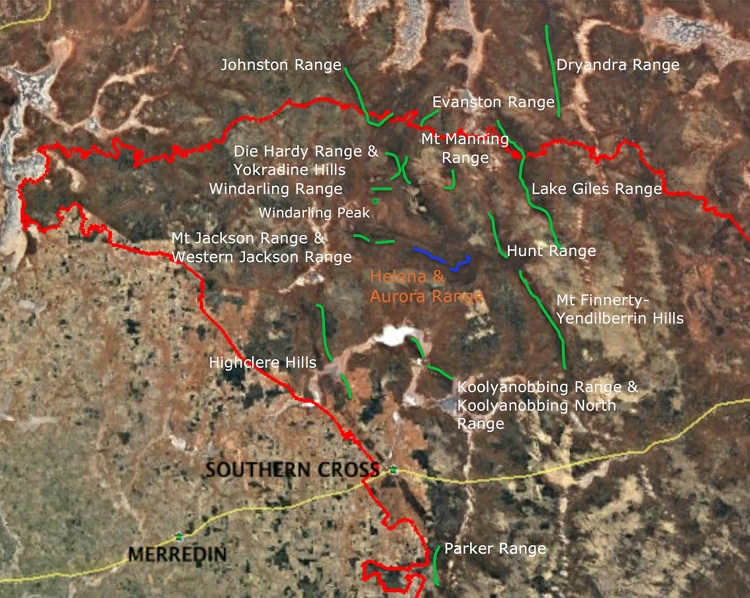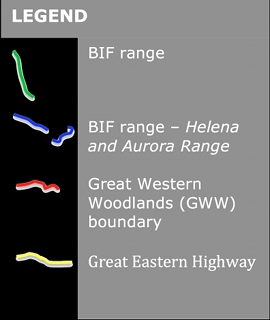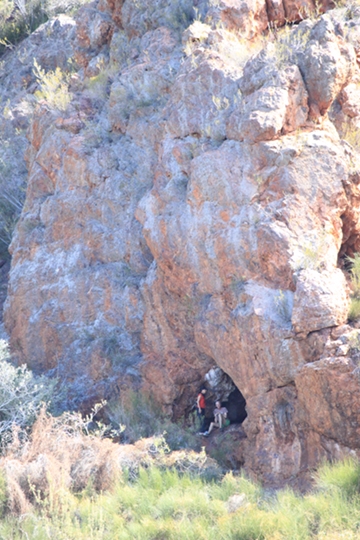Significance of Helena and Aurora Range
Helena and Aurora Range, Bungalbin has been referred to as UNIQUE
the "Jewel in the Crown" of the BIF ranges in the Great Western Woodlands

LOCATIONS OF BIF (Banded Ironstone Formation) RANGES IN THE YILGARN

Within the Great Western Woodlands and Coolgardie Bioregion there are six highly significant Banded Ironstone Formation (BIF) ranges based on landform and conservation values.
These are:
- Koolyanobbing Range (mined since 1960s)
- Mt Jackson Range (mined since 2004)
- Windarling Range (mined since 2004)
- Die Hardy Range (minimal exploration)
- Mt Manning Range (minimal exploration)
- Helena and Aurora Range (mine proposal referred to EPA in 2014 disallowed in December 2017)
Only three of these six highly significant BIF ranges are currently INTACT* and near PRISTINE.
They are:
- Helena and Aurora Range
- Mt Manning Range
- Die Hardy Range
Of the remaining seven BIF ranges shown in the region and Great Western Woodlands, four are INTACT having none or minimal exploration activity:
- Hunt Range
- Dryandra Range
- Lake Giles Range
- Evanston Range
* ‘INTACT’ refers to a BIF range that has not been mined (i.e. sections of the range removed) and has had minimal exploration activity (i.e. drill pads and tracks cut in to the hill slopes).
Helena and Aurora Range, Bungalbin is the larger of the six highly significant intact BIF ranges, with unique BIF outcropping and four endemic flora (see below).The remaining BIF ranges, listed and shown on the map, are low lying, and although of great consevation value in themselves, they do not have as high landform or flora conservation values as the larger BIF ranges.
It can be seen in the figure above, that the most significnat BIF ranges, although considerably higher, are often shorter than the lower lying BIF ranges
Landform, flora and fauna values are intrinsically linked
The greater the landform values - the greater the flora and fauna conservation values
The main range of Helena and Aurora, Bungalbin is 12km long, lies in a south-east to north-west direction, and has slopes that rise 200m above the surrounding plains that attain heights of 685m to 704m AHD, are convoluted, and support large BIF outcrops.
- The Helena and Aurora Range, Bungalbin supports four endemic rare plant species, two of which grow on the BIF outcropping. Other BIF ranges support just the one endemic rare plant species (on their BIF outcropping) or none at all.
- The four endemic plant species on the main range of Helena and Aurora are described as “ironstone loving” and are listed as Threatened. They don’t grow anywhere else in the world.
- The BIF slopes of Helena and Aurora's main range support stands of 15m to 30m high Inland White Gums, Eucalyptus capillosa subsp capillosa, (absent from slopes of smaller BIF ranges though they can grow near the base).
- The large BIF outcropping provides nest sites for Little Woodswallow and Peregrine Falcon, as on other highly significant BIF ranges with large outcropping.
- The greater the height and length of the BIF range the larger the population of Dryandra arborea (P4, restricted to BIF landforms) it supports,. Dryandra arborea is an important food plant for honeyeaters, parrots, Western Pygmy Possum and insects.
- The southern slopes provide refuge areas for fauna with their: high water infiltration rates, high water availability, cooler ambient, surface and soil temperatures, and denser vegetation.
- The larger the BIF range the greater the size and significance of the refuge area for fauna and flora.

